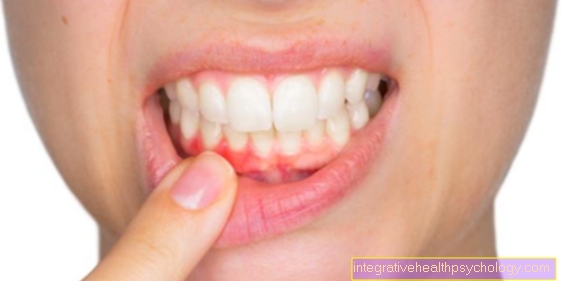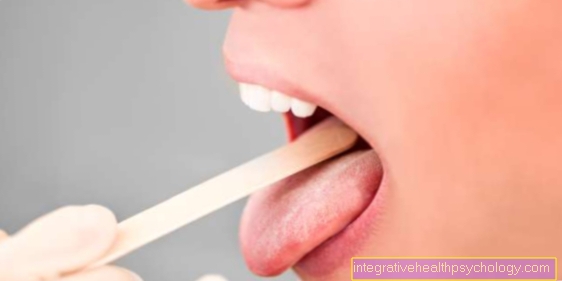Tartar
introduction
Tartar describes mineralized plaque that has been insufficiently removed as a result of poor oral hygiene. These mineralized deposits can no longer be removed with a toothbrush or conventional methods. A visit to the dentist is essential. A professional teeth cleaning is carried out there.
Read more on the topic: Oral hygiene

What is tartar?
With tooth decay, tartar is one of the most common dental diseases. Tartar is a hard and very firmly adhering deposit on the tooth crowns as a result of the precipitation of calcium from the saliva, mixed with bacteria and mucous membrane cells. It is caused by the calcification of the dental plaque. Tartar forms particularly heavily on the inner surfaces of the lower front teeth and on the cheek side of the first molar. The reason for this is the fact that the openings in the salivary glands lie under the tongue opposite the lower front teeth and opposite the first molar.
The start of the tartar build-up is always at the neck of the tooth, where the plaque first settles. Not only can we humans have tartar, our pets, dogs and cats, develop tartar too, especially when given soft canned food. The consequences are bad breath and inflamed gums. The vet will remove the tartar under anesthesia.
The tartar is porous and the bacteria can collect and multiply in the cavities. The surface of the tartar is rough and therefore well suited for further plaque to accumulate and for the tartar to continue to grow after it has become calcified. If it is not removed, it will overgrow the tooth and gums. A real wall of tartar is created on the inner surfaces of the lower front teeth, which can also penetrate the interdental spaces and is thus also visible on the front. The color of the tartar varies from gray to brown. For cigar or pipe smokers, the tar can make it dark to blackish. This form of tartar is called supragingival Tartar is called because it is located above the gums.
The formation of tartar is not the same in all people. There are people who develop new tartar very quickly and others who develop very little tartar. It is probably due to the composition of the individual saliva whether one belongs to one group or the other. There are also differences in the removal of the tartar. Some are relatively easy to remove, others are extremely stuck.
But tartar can also form in the gum pockets. Since it is located below the gums, it is called subgingival Called tartar or as calculus. This tartar is harder than that Supragingival and has a darker color. It is also formed from calcified deposits, but it does not get its mineralization from saliva, but from inflammatory tissue secretions. The concrements are extremely firmly attached to the root of the tooth and are becoming more and more extensive due to new deposits.
Consequences of tartar
The tartar itself is not dangerous, but it creates excellent conditions for the accumulation of new dental plaque, which in turn is a hazard mainly to the gums. With the help of the tartar, the bacteria-containing plaque comes into close contact with the gums, especially on the underside, which leads to inflammation of the gingiva. And with it at the beginning of gingivitis and even periodontitis (inflammation of the gums).
Read more on the topic: Causes of inflammation of the gums
Inflammation of the gums caused by tartar
Despite thorough oral hygiene, tartar is very difficult to remove in the area of the gum line. In this area, bacteria can enter the gingival pockets and cause massive inflammation there. These can even be so bad that bone loss and tooth loss can occur. Therefore, the tartar should be regularly removed professionally.
Read more on the topic: Inflammation of the gums
Tartar and bad breath
Tartar is hardened, mineralized layers of bacteria in the area of the teeth. If they are not removed properly, these lead to damage to the teeth and, among other things, to the development of bad breath. The bacteria that do not need oxygen in particular are involved in the development of bad breath by breaking down protein-rich and sugary food residues. To avoid bad breath, the tartar should be removed regularly by the dentist and thorough oral hygiene should be observed. The use of mouthwashes or mouthwashes can also help.
Read more on the topic: Fight bad breath
therapy
Tartar cannot be removed through home dental care; this can only be done in the dental practice. Professional teeth cleaning must be performed; the dentist will blast the tartar off the teeth with the help of ultrasound. Since this creates heat, water has to be used for constant cooling. Hand instruments are also used to remove the last remnants of the tartar. The concrements are also removed using ultrasound and so-called scalers, hand instruments with which the concretions are removed from the tooth root, together with the bacterial plaque. We strongly advise against removing tartar on your own!
Read more on the topic: How can you remove tartar yourself?
Removal of tartar
The tartar is removed by the dentist using ultrasound or hand instruments. The patient cannot remove tartar himself.
Removing the tartar is usually not very painful.
However, particularly stubborn tartar can be removed independently with a tartar scraper.
Read more on the topic: Remove tartar
Ultrasound tartar removal
Ultrasound is the most effective and reliable method for removing tartar. For this purpose, specialist retailers offer various ultrasonic toothbrushes that are used in combination with special toothpastes. The ultrasound creates small bubbles in the pastes that are supposed to loosen plaque (soft plaque) and tartar when they burst in the mouth. With the help of this method, the teeth are thoroughly cleaned without damaging the tooth substances (tooth enamel and dentin). At the same time, areas that are difficult to clean can also be reached.
Ultrasound is also used for professional teeth cleaning, which is also recommended for removing tartar.
Find out more about: Ultrasonic toothbrush
What is the best way to remove tartar?
Tartar should always be removed by a dentist as part of a professional teeth cleaning. This prevents injuries to the oral mucosa and gums, which can be the cause of severe inflammation. Since tartar also forms below the gumline, it cannot be completely removed by the patient himself.
If it is not removed properly, it can lead to severe inflammation, periodontitis (inflammation of the teeth holding apparatus), bone loss or even tooth loss over a long period of time. There are several options available for tartar cleaning in the form of ultrasound, electric toothbrushes, tartar erasers or tartar removers.
Professional tooth cleaning
Professional tooth cleaning (PZR) is an effective, preventive treatment method to protect against tooth and oral diseases. It is carried out either by the dentist himself or by a specially trained prophylactic assistant. In addition to the removal of soft and hard plaque (plaque and tartar), all teeth are polished and all teeth are fluoridated (with fluoride gel).
At the same time, the patient is given valuable tips on thorough oral hygiene. The PZR is used for the thorough removal of bacterial deposits even in hard-to-reach places in the mouth. It thus supports daily teeth cleaning and should be carried out once or twice a year.
Read more on the topic: Professional tooth cleaning
Home remedies for tartar
Various home remedies are recommended in various newspapers and on the Internet to remove tartar. In addition to using baking soda or vinegar, the use of sesame seeds is also recommended. Sesame seeds should be chewed for about 20 minutes and then the teeth should be brushed with a dry toothbrush. This should be repeated several times a week to loosen the tartar.
The other home remedies such as vinegar and baking soda are rather not recommended, as they damage and roughen the tooth enamel due to the friction generated. This creates a larger area for bacteria and plaque to adhere to the teeth. When using vinegar, the problem lies in the aggressive acetic acid, which attacks the tooth enamel. The use of tea tree oil is also not recommended.
Lemon against tartar
The use of lemons is not recommended. The aggressive citric acid attacks the tooth enamel and roughens it. As a result, plaque and bacteria increasingly stick to the teeth and promote the development of caries. A little lemon juice in a glass of water to freshen the breath as well as for
baking powder
Baking soda should also not be used to remove tartar. In contrast to the other home remedies, the baking powder does not contain any acid, but the tooth enamel is roughened and permanently damaged by the friction (emery effect). As a result, it is no longer as resistant to attacks from caries bacteria.
What is a tartar eraser?
With the help of a tartar eraser you can remove easily loosened tartar as well as slight tooth discoloration. It consists of a rubber-like substance that is covered with specific crystals. This gives the gum eraser a slightly abrasive effect. As with all methods of tartar removal, injury to the gums should be avoided to prevent inflammation from occurring.
What is a tartar scratch?
The tartar scraper (tartar scaler) is an instrument that is characterized by two differently shaped, hook-shaped sides. The dentist also uses it to remove tartar in the area between the interdental spaces and the gum line (part of the gum that is directly adjacent to the tooth). With the help of a mirror, the tartar can be removed from the inside and the back of the teeth. Nevertheless, the instrument should only be used with great care, as incorrect use can lead to serious injuries to the gums and oral mucosa. In addition, the scaler should always be guided away from the gums towards the teeth
Read more on the topic: Tartar scratches
prophylaxis
The best prophylaxis is daily dental care and professional cleaning of the teeth (see professional teeth cleaning). Because where there is no plaque, no tartar can form. There are also toothpastes that contain pyrophosphate, among other ingredients. Clinical studies have shown that pyrophosphate is not able to completely prevent the formation of tartar, but can reduce it by about 30%.
What does a tartar removal cost?
The cost of tartar removal varies according to the amount of work involved and the number of teeth to be cleaned. The most effective method is professional teeth cleaning. The costs for this are between 80 and 120 euros per treatment. Some statutory health insurances either pay one PZR per calendar year or grant specific treatment grants. The private health insurances reimburse the treatment in full. The cost of an ultrasonic toothbrush depends on its features and function. As a rule, between 90 and 190 euros must be invested. The dentist can help in choosing the right device.
Tartar or tooth decay - what's the difference?
A precise distinction between tartar and tooth decay is not that easy for the layperson. If in doubt, a dentist should always be consulted.
Caries
Tooth decay (tooth decay) is a contagious disease caused by specific bacteria. These convert sugar (carbohydrates) into acid and soften the tooth enamel. The resulting caries can then spread to the inside of the tooth and damage the tooth. The first signs of tooth decay appear in the form of white or brown spots on the teeth. Pain usually only occurs when the tooth enamel has already broken through.
Read more about the: Symptoms of tooth decay
Summary
Tartar forms as a result of the calcification of the dental plaque. Because of its rough surface, it is an ideal starting point for new plaque. If it is not removed, it will keep growing. Because of its proximity to the gums, it creates gingivitis. Tartar cannot be removed by oral hygiene at home, but only by the dentist. Plaque-free teeth, through a healthy dental routine, are the best prevention against tartar. Toothpastes that contain pyrophosphate are helpful.























.jpg)





